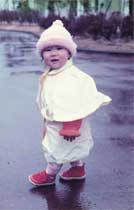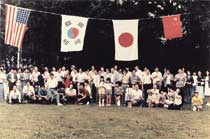Internationalizing KEK:
The Early Days
In recent times, the number of foreign researchers and the level of international activity at KEK is rather high. This has not always been the case. In 1982, when I first came to KEK started in 1982 for a year-long sabbatical leave, there were three foreign researchers at KEK, and not many more in all of Tsukuba. (In 1982, seeing a foreigner in Tsukuba was a rare event; when we came across each other we either already knew each other or, if not, introduced ourselves.) During this visit, I shared an office with Steve Schnetzer, who, at the time, was a KEK post-doc working on a PS experiment. Steve's PS experiment finished and my attempts to work with one of the emerging TRISTAN experiments was not very successful. We, therefore, decided to pursue some ideas for a TRISTAN experiment that resulted in the Letter of Intent for the AMY experiment. Our ideas must have been pretty good, because the KEK program committee gave us some kind of a tentative approval---with a condition that we find some collaborators. Our LOI had only six names on it, all from the US. When our efforts to find collaborators in Japan failed, we looked elsewhere. Our first success happened in 1983, when Steve Schnetzer, while touring in China, presented himself at the guardhouse of IHEP in Beijing and asked to see the laboratory. After some scrambling, Zheng Zhi-Peng, was given the task of dealing with the crazy foreigner at the front gate. As it turned out, Steve and Zhi-Peng got on famously and, by the time Steve's tour of IHEP was over, Zhi-Peng was enthusiastic about joining AMY. After some correspondence, we happily added IHEP to the collaboration list that was part of the full AMY proposal that was submitted in Fall 1983.
 |
Amy-chan, the author's next-door neighbor in 1982 was the inspiration for the name of the AMY experiment. |
The next big breakthrough occurred when attempts by a group of Korean physicists to join one of the two approved TRISTAN experiments were not successful. When this happened (by then, I was back in the US), I was encouraged by Satoshi Ozaki to call Joo Sang Kang of Korea University and, as a result of this conversation, I visited Seoul in January 1984 and gave a talk at Korea University (where, in the audience, were such future high energy physics luminaries as Young Kee Kim and Sun Kee Kim). Soon afterwards, the Korea University group joined AMY.
The international structure of the AMY group became complete when Aki Maki returned to KEK after a stint at Fermilab. Aki was enthusiastic about AMY physics and, with enthusiatic encouragement from Kasuke Takahashi ("AMY's Godfather"), recruited a highly talented KEK-based group that became the core element of the team that presented itself to the KEK program committee in March 1984.
After lengthy discussions, and in spite of grumbling from some committee members that we were a "bunch of amateurs," KEK Director-General Nishikawa decided to take a chance on us and approved the AMY experiment.
We did our best to not disappoint Professor Nishikawa. Although our high hopes for discovering the top-quark or a new heavy lepton were not to be, we did our best to make a productive physics program from what we had. For some reason---I personally think that it was the healthy mix of different backgrounds and viewpoints---AMY was particularly successful: of the ten most highly cited papers from TRISTAN, seven were produced by AMY. Not bad for a bunch of amateurs!
 |
The first AMY summer picnic in 1985 was a chance for all the KEK staff to enjoy good fellowship with visitors from China, Korea and the US. |
After the end of the TRISTAN program, this high degree of internationalization and excellent productivity was successfully transferred to Belle. In Belle, like AMY, a majority of the researchers are at foreign institutions. Also, like AMY, this environment of multiple backgrounds and viewpoints has proven to be extremely invigorating. In spite of a much smaller contingent of researchers and, until very recently, considerably less integrated luminosity than our competing experiment, the Belle group has more than held its own and has produced a large number of results, including some discoveries of profound importance.
The exciting and vibrant intellectual working environment that we experienced in AMY is the reason many of us continued on in Belle. This despite a number of what I consider to be serious hurdles for foreigners working at KEK and in Japan. These include the poor long-term employment prospects for foreigners in Japan, the abundant red-tape involved in living in Japan and working at KEK, and the exclusion of the foreign researchers from major decision-making at KEK.
Today, internationalization is central to virtually all of KEK's programs. In particular, the collaborations with China and Korea that started with AMY have become deep and lasting relations between the communities that encompass almost all of the laboratory's activities. Moreover, collaborations with other national communities have proven to be similarly productive and valuable. KEK is truly an exciting cosmopolitan place to work. Interestingly, this all started with collaborations that were initiated by foreigners and done externally to KEK: with Steve Schnetzer and Zhi-Peng Zheng's chance encounter at IHEP in 1983 and my call from the US to Joo Sang Kang in Seoul, about six months later.
